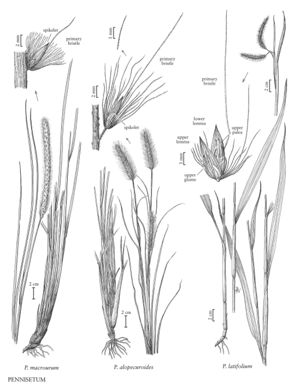Pennisetum alopecuroides
Plants perennial; cespitose. Culms 30-100 cm, erect; nodes glabrous. Sheaths glabrous, margins ciliate; ligules 0.2-0.5 mm, membranous, ciliate; blades (10)30-60 cm long, 2-8(12) mm wide, flat to folded, glabrous, margins ciliate basally. Panicles all terminal, 6-20 cm long, 20-53 mm wide, fully exerted from the sheaths, erect, green to brown, deep purple, or stramineous to creamy-white; rachises terete, with pubescent hairs. Fascicles 9-16 per cm; fascicle axes 1.5-5.6 mm, with a stipelike base of 1-5.6 mm and 1(2) spikelet(s); outer bristles 13-19, 0.8-15.6 mm; inner bristles 7-10, 11.2-30 mm, scabrous; primary bristles 26.7-35 mm, scabrous, usually not noticeably longer than the other bristles. Spikelets 5.5-8.4 mm, sessile or subsessile, glabrous; pedicels to 0.1 mm; lower glumes 0.2-1.4 mm, veinless; upper glumes 2-4.9 mm, to 1/2 as long as the spikelet, 1-5-veined, acute to broadly acute; lower florets sterile; lower lemmas 4.9-8.1 mm, 7-9(10)-veined; lower paleas absent; upper lemmas 5.2-7.6 mm, 5-7-veined, acuminate; anthers 3, 3-4.5 mm. 2n = 18.
Distribution
Pa., Ohio, N.C., N.Y., Ark., Ill.
Discussion
Pennisetum alopecuroides is native to southeast Asia. It is frequently grown as an ornamental in the Flora region.
Selected References
None.
